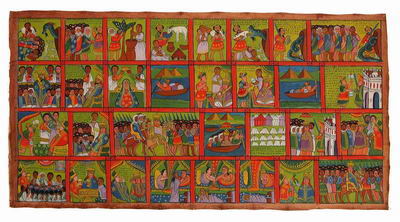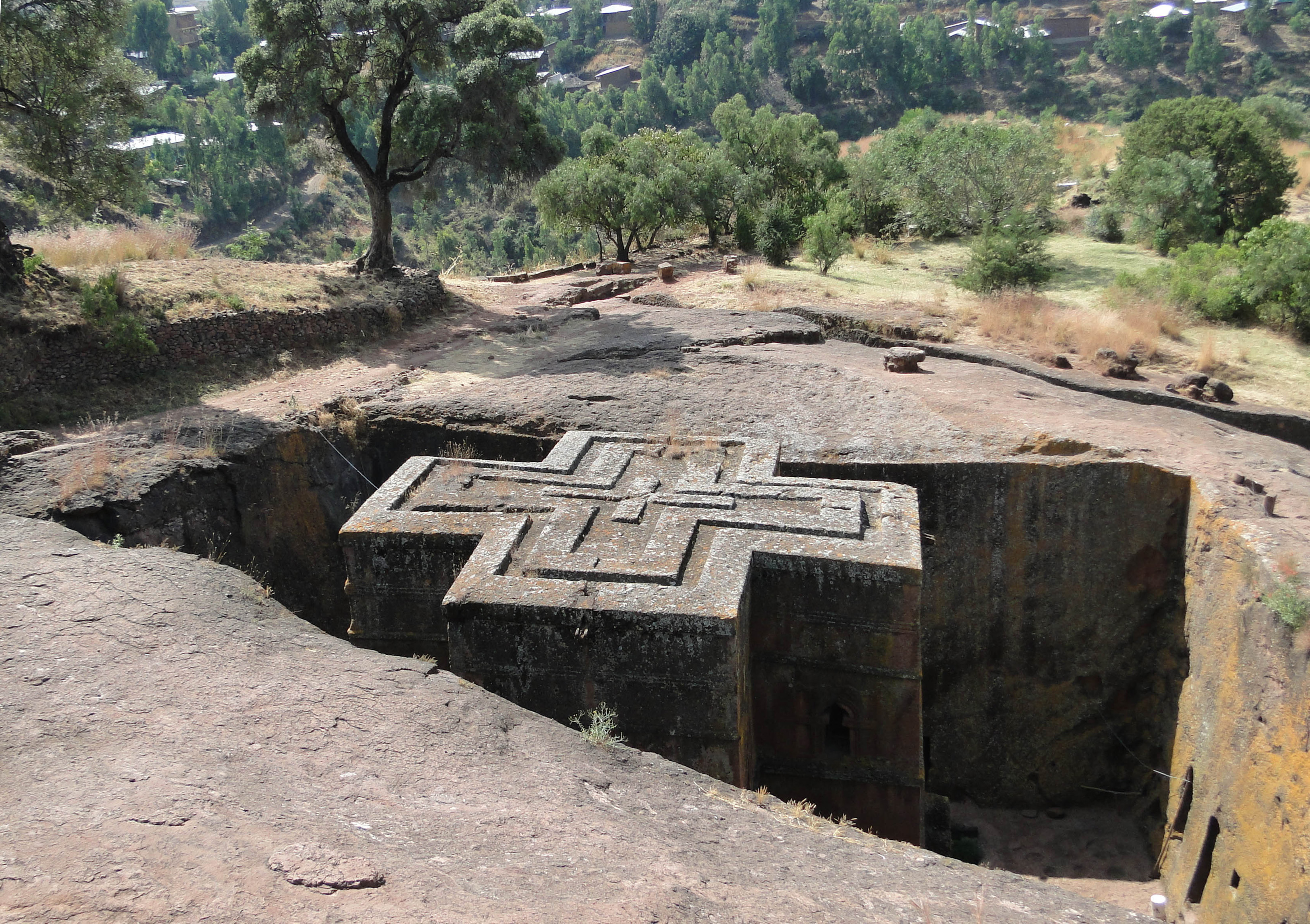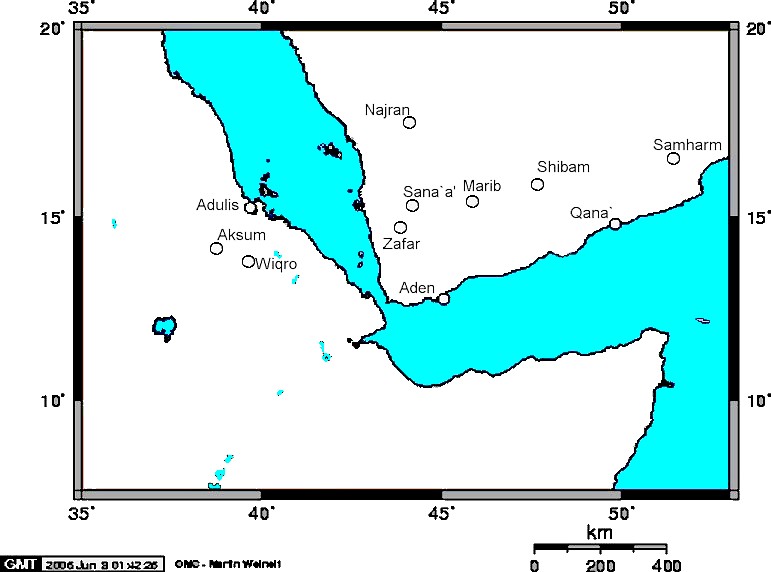|
Kebra Negast
The Kebra Nagast, var. Kebra Negast ( gez, ክብረ ነገሥት, ), or The Glory of the Kings, is a 14th-century national epic from Ethiopia, written in Ge'ez by Nebure Id Ishaq of Axum, by the office of Abuna Abba Giyorgis and at the command of the governor of Enderta Ya'ibika Igzi'. The text, in its existing form, is at least 700 years old and although clearly legendary is considered by many Ethiopian Christians to be a historically reliable work. It is considered to hold the genealogy of the Solomonic dynasty, which followed the Ethiopian Orthodox Church. The text contains an account of how the Queen of Sheba (Queen Makeda of Ethiopia) met King Solomon and about how the Ark of the Covenant came to Ethiopia with their son Menelik I (Menyelek). It also discusses the conversion of Ethiopians from the worship of the Sun, Moon, and stars to that of the "Lord God of Israel". As the Ethiopianist Edward Ullendorff explained in the 1967 Schweich Lectures, "The ''Kebra Nagast' ... [...More Info...] [...Related Items...] OR: [Wikipedia] [Google] [Baidu] |
Saba Ephiop
Saba may refer to: Places * Saba (island), an island of the Netherlands located in the Caribbean Sea * Şaba (Romanian for Shabo), a town of the Odesa Oblast, Ukraine * Sabá, a municipality in the department of Colón, Honduras * Saba (river), Leningrad Oblast, Russia * Saba, Iran, a village in Bushehr Province * Saba District, Yamaguchi, district located in Yamaguchi Prefecture, Japan * Saba Island, United States Virgin Islands, an island three miles south of St. Thomas * Saba Bank, the largest submarine atoll in the Atlantic Ocean, located in the Caribbean Netherlands * Saba Rock, a small island in the British Virgin Islands * Mukim Saba, a mukim in Brunei * Kfar Saba, a city in Israel * Kafr Saba, a historical village in Mandatory Palestine History * Sabaʾ, an ancient kingdom in South Arabia * Saba' (Sheba), an ancient kingdom mentioned in Biblical and Islamic traditions which may be the same as Sabaʾ People * Saba (name), a given or surname (includes list of people wit ... [...More Info...] [...Related Items...] OR: [Wikipedia] [Google] [Baidu] |
Zagwe Dynasty
The Zagwe dynasty ( Ge'ez: ዛጔ ሥርወ መንግሥት) was an Agaw medieval dynasty that ruled the northern parts of Ethiopia and Eritrea, after the historical name of the Lasta province. Centered at Lalibela, it ruled large parts of the territory from approximately 900 to 1270 CE, when the last Zagwe King Za-Ilmaknun was killed in battle by the forces of the Amhara King Yekuno Amlak. The name of the dynasty is thought to derive from the ancient Ge'ez phrase ''Ze- Agaw'', meaning "of the Agaw", in reference to the Mara Tekle Haymanot, the founder of the dynasty. Zagwe's best-known King was Gebre Mesqel Lalibela, who is credited with having constructed the rock-hewn monolithic churches of Lalibela. David Buxton has stated that the areas under the direct rule of the Zagwe kings apart from the centre of power in Lasta "probably embraced the highlands of modern Eritrea, Tigray, Waag and Bete Amhara and thence westwards towards Lake Tana (Begemder)." Unlike the practice of ... [...More Info...] [...Related Items...] OR: [Wikipedia] [Google] [Baidu] |
Anti-Judaism
Anti-Judaism is the "total or partial opposition to Judaism as a religion—and the total or partial opposition to Jews as adherents of it—by persons who accept a competing system of beliefs and practices and consider certain genuine Judaic beliefs and practices inferior." According to Douglas Hare, there are three types of Anti-Judaism: (1) Prophetic Anti-judaism - the criticism of the beliefs and religious practices of the religion; (2) Jewish-Christian anti-Judaism - Jews who believe that Jesus is the Messiah; and (3) Gentilizing anti-Judaism - emphasis on the gentile character of the new movement and claiming god's rejection of the "old" Israel. Anti-Judaism, as a rejection of a particular way of thinking about God, is distinct from antisemitism, which is more akin to a form of racism. Scholars wishing to blur the line between theology and racism have since coined the term religious antisemitism. Both the Christian doctrine of supersessionism and the Islamic doctrine ... [...More Info...] [...Related Items...] OR: [Wikipedia] [Google] [Baidu] |
Gabra Masqal (born 1947), Coptologist
{{disambiguation ...
Gabra may refer to: *The Gabra people of eastern Africa *Gabra (village), village in Western Bulgaria, part of Elin Pelin Municipality, Sofia Province * Gabra Manfas Qeddus, Ethiopian Christian saint, and the founder of the monastery of Zuqualla *Gabra Mika'el, Roman Catholic martyr and associate of saint Giustino de Jacobis *Gawdat Gabra Dr. Gawdat Gabra (born 1947) ( ar, جودت جبرا, Coptic: Ⲅⲁⲩⲇⲁⲧ Ⲅⲁⲃⲣⲁ) is a Coptologist; he finished his bachelor's degree in Egyptian Antiquities – Cairo University 1967 and PhD in Coptic Antiquities University of M ... [...More Info...] [...Related Items...] OR: [Wikipedia] [Google] [Baidu] |
Najran
Najran ( ar, نجران '), is a city in southwestern Saudi Arabia near the border with Yemen. It is the capital of Najran Province. Designated as a new town, Najran is one of the fastest-growing cities in the kingdom; its population has risen from 47,500 in 1974 and 90,983 in 1992 to 246,880 in 2004 and 505,652 in 2017. The population mostly originates from the ancient tribes of Yām, Mákram, and Hamdan. Najranis are Muslims, with Shia, Ismaili forming the plurality of the religious adherents. Hanbali, Shafi'i, and Maliki Sunnis form the second-largest religious group in the city, while the Zaydi Shia form the smallest religious group. The Arabic term ' has at least two meanings: both the wooden frame on which a door opens and also 'thirsty'. Local tradition also has it that the land derived its name from the first man to settle in the area, Najran ibn Zaydan ibn Saba ibn Yahjub ibn Yarub ibn Qahtan. Najran was the Yemeni centre of cloth making and originally, the ''kisw ... [...More Info...] [...Related Items...] OR: [Wikipedia] [Google] [Baidu] |
Kaleb Of Axum
Kaleb (), also known as Saint Elesbaan, was King of Aksum, which was situated in modern-day Eritrea and Ethiopia. Procopius calls him "Hellestheaeus", a variant of grc-koi, Ελεσβόάς version of his regnal name, gez, እለ አጽብሐ, translit=ʾƎllä ʾAṣbəḥa (''Histories'', 1.20). Variants of his name are Hellesthaeus, Ellestheaeus, Eleshaah, Ellesboas, Elesbaan, and Elesboam. At Aksum, in inscription RIE 191, his name is rendered in unvocalized Gə‘əz as KLB ’L ’ṢBḤ WLD TZN (Kaleb ʾElla ʾAṣbeḥa, son of Tazena). In vocalized Gə‘əz, it is (Kaleb ʾƎllä ʾAṣbəḥa). Kaleb, a name derived from the Biblical character Caleb, was his given name; on both his coins and inscriptions he left at Axum, as well as Ethiopian hagiographical sources and king lists, he refers to himself as the son of Tazena. History Procopius, John of Ephesus, and other contemporary historians recount Kaleb's invasion of Yemen around 520, against the Himyarit ... [...More Info...] [...Related Items...] OR: [Wikipedia] [Google] [Baidu] |
Saint Frumentius
In religious belief, a saint is a person who is recognized as having an exceptional degree of holiness, likeness, or closeness to God. However, the use of the term ''saint'' depends on the context and denomination. In Catholic, Eastern Orthodox, Anglican, Oriental Orthodox, and Lutheran doctrine, all of their faithful deceased in Heaven are considered to be saints, but some are considered worthy of greater honor or emulation. Official ecclesiastical recognition, and consequently a public cult of veneration, is conferred on some denominational saints through the process of canonization in the Catholic Church or glorification in the Eastern Orthodox Church after their approval. While the English word ''saint'' originated in Christianity, historians of religion tend to use the appellation "in a more general way to refer to the state of special holiness that many religions attribute to certain people", referring to the Jewish tzadik, the Islamic walī, the Hindu rishi or Sikh ... [...More Info...] [...Related Items...] OR: [Wikipedia] [Google] [Baidu] |
Pharaoh's Daughter (wife Of Solomon)
The Pharaoh's daughter is a figure in the Hebrew Bible who is described as marrying Solomon to cement a political alliance between the Kingdom of Israel (united monarchy), United Monarchy of Israel and Ancient Egypt, Egypt. Biblical narrative While there is no archaeological evidence of a marriage between an Egyptian princess, the daughter of a Pharaoh, and a king of united Israel, claims of one are made at several places in the Hebrew Bible. (Note: All scripture quotes are taken from the 1917 Jewish Publication Society of America Version, Jewish Publication Society Bible, now in the public domain.) A marriage alliance *1 Kings 3:1 says, :"And Solomon became allied to Pharaoh king of Egypt by marriage, and took Pharaoh's daughter, and brought her into the city of David, until he had made an end of building his own house, and the house of the Lord, and the wall of Jerusalem round about." The fact that Pharaoh's daughter has been singled out in the accounts of Solomon is sign ... [...More Info...] [...Related Items...] OR: [Wikipedia] [Google] [Baidu] |
Gregory The Illuminator
Gregory the Illuminator ( Classical hy, Գրիգոր Լուսաւորիչ, reformed: Գրիգոր Լուսավորիչ, ''Grigor Lusavorich'';, ''Gregorios Phoster'' or , ''Gregorios Photistes''; la, Gregorius Armeniae Illuminator, cu, Svyashchennomuchenik Grigory Armyansky, prosvetitel’ Velikoy Armenii, episkop Священномученик Григорий Армянский, просветитель Великой Армении, эпископ – ) was the 12th Catholicos-Patriarch and the first official head of the Armenian Apostolic Church. He was a religious leader who converted Armenia from paganism to Christianity in 301. He is also the patron saint of the church. Early life Gregory was the son of the Armenian Parthian nobles Anak the Parthian and Okohe. His father, Anak, was a Prince said to be related to the Arsacid Kings of Armenia or was from the House of Suren, one of the seven branches of the ruling Arsacid dynasty of Sakastan. Anak was char ... [...More Info...] [...Related Items...] OR: [Wikipedia] [Google] [Baidu] |
Gregory Thaumaturgus
Gregory Thaumaturgus or Gregory the Miracle-Worker ( grc, Γρηγόριος ὁ Θαυματουργός, ''Grēgórios ho Thaumatourgós''; la, Gregorius Thaumaturgus; 213 – 270), also known as Gregory of Neocaesarea, was a Christian bishop of the 3rd century. He has been canonized as a saint in the Catholic and Orthodox Churches. Biography Gregory was born around AD 213 to a wealthy pagan family in Neocaesarea (modern Niksar, then the capital of the area of Pontus in Asia Minor). Little is known of his pastoral work, and his surviving theological writings are in an incomplete state. This lack of knowledge partially obscures his personality, despite his historical importance, and his immemorial title Thaumaturgus, "the wonder-worker" in Latinized Greek, casts an air of legend about him. Nevertheless, the lives of few bishops of the third century are so well authenticated; the historical references to him permit a fairly detailed reconstruction of his work. Origina ... [...More Info...] [...Related Items...] OR: [Wikipedia] [Google] [Baidu] |
Second Council Of Ephesus
The Second Council of Ephesus was a Christological church synod in 449 AD convened by Emperor Theodosius II under the presidency of Pope Dioscorus I of Alexandria. It was intended to be an ecumenical council, and it is accepted as such by the miaphysite churches but was rejected by the Chalcedonian dyophysites. It was explicitly repudiated by the next council, the Council of Chalcedon of 451, recognised as the fourth ecumenical council by Chalcedonian Christians, and it was named the ''Latrocinium'' or "Robber Council" by Pope Leo I; the Chalcedonian churches, particularly the Roman Catholic and Eastern Orthodox communions, continue to accept this designation, while the Oriental Orthodox repudiate it. Both this council and that at Chalcedon dealt primarily with Christology, the study of the nature of Christ. Both councils affirmed the doctrine of the hypostatic union and upheld the orthodox Christian doctrine that Jesus Christ is both fully God and fully man. The Second Council ... [...More Info...] [...Related Items...] OR: [Wikipedia] [Google] [Baidu] |
Domnus II Of Antioch
Domnus II, was Patriarch of Antioch between 442 and 449 and a friend of the influential Bishop of Cyrrhus, Saint Theodoret. Biography Domnus was ordained deacon by the Patriarch Juvenal of Jerusalem in 429 AD and remained at the Monastery of St. Euthymius in Palestine for two years. In 431 AD he left the monastery to aid his uncle, Patriarch John I of Antioch, as part of the Nestorian Controversy. Domnus went to Antioch to support proponents of the School of Antioch in favour of Nestorianism against supporters of Pope Cyril of Alexandria and his successor Dioscurus. In 442 AD, upon the death of his uncle, Domnus was elected successor with support he had acquired in Antioch. In 445 AD he summoned a synod of Syrian bishops and confirmed the deposition of Athanasius of Perrha. In 447 AD he consecrated Irenaeus to the see of Tyre (Theodoret, ''Epistle'' 110); but emperor Theodosius II, commanded that the appointment should be annulled on the grounds that Irenaeus was both a ''dig ... [...More Info...] [...Related Items...] OR: [Wikipedia] [Google] [Baidu] |






